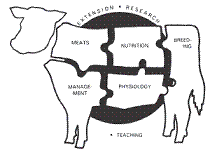Animal Science, Department of

Nebraska Beef Cattle Reports
Date of this Version
2019
Citation
2019 Nebraska Beef Cattle Report
Abstract
To meet consumer trends, alternative curing ingredients are used to replace sodium nitrite and cure accelerators. Due to the complexity of meat, it is challenging to compare traditional and alternative ingredients for curing reactions. Using a model system, sources of nitrite (traditional, sodium nitrite and alternative, cultured celery juice powder), salt, and cure accelerators (traditional, sodium erythorbate, or alternative, cherry juice powder) at ingoing sodium nitrite concentrations of 10, 50, 100, 150, or 200 ppm were evaluated for curing reactions. More complete curing reactions were indicated by a higher concentration of cured meat pigment, and lower sulfhydryl groups. Lower residual nitrite indicates reduction of nitrite into nitric oxide, and higher reducing capacity indicates a higher concentration of antioxidants. Traditional nitrite and celery juice powder treatments had similar concentrations of residual nitrite and cured meat pigment. Celery juice powder treatments with and without a cure accelerator had the most sulfhydryl groups and a high residual reducing capacity. This research demonstrates cultured celery juice powder and cherry powder develop similar concentrations of cured meat pigment as traditional sodium nitrite and sodium erythorbate, but antioxidants native to alternative ingredients may lessen the production of nitrosated cysteine.
Included in
Large or Food Animal and Equine Medicine Commons, Meat Science Commons, Veterinary Preventive Medicine, Epidemiology, and Public Health Commons


Comments
Copyright © The Board Regents of the University of Nebraska.